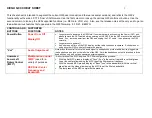
7
3.4
Fairing
Generally, the sensor is mounted without a fairing. However, a fairing does provide a
level mounting surface. Nearly all vessels have some deadrise angle at the transducer
mounting location. If the transducer is mounted directly to the hull, the sound beam will
be tilted off the vertical at the same angle as the deadrise angle. A fairing is
recommended for
metal
housings if the deadrise angle at the mounting location
exceeds 1
0
.
Caution:
Never use a fairing with a plastic housing; the protruding transducer would
be vulnerable to damage from impact.
4 Installation
Cored fiberglass hul
l—Follow separate instructions on page 4.
4.1
Hole Drilling
Warnin
g: Always wear safety goggles and a dust mask.
1. Drill a 3 mm or 1/8" pilot hole from inside the hull. If there is a rib, strut, or other
hull irregularity near the selected mounting location, drill from the outside.
Note: If the pilot hole is drilled in the wrong location, drill a second hole in a better
location. Apply masking tape to the outside of the hull over the incorrect hole and
fill it with epoxy.
2. Using the appropriate size hole saw, cut a hole from outside of the hull (see table
on page 1).
Note: All flush models require a countersink tool to create a “seat” in the hull.
3. Sand and clean the area around the hole, inside and outside, to ensure that the
sealant will adhere properly to the hull. If there is any petroleum residue inside the
hull, remove it with either mild household detergent or a weak solvent (alcohol)
before sanding.
Metal hul
l—Remove all burrs with a file and sandpaper.
Содержание FI-3001
Страница 1: ...0 ...
Страница 2: ...1 ...
Страница 3: ...2 ...
Страница 14: ...13 22345 1 Edidtion 2 ...
































